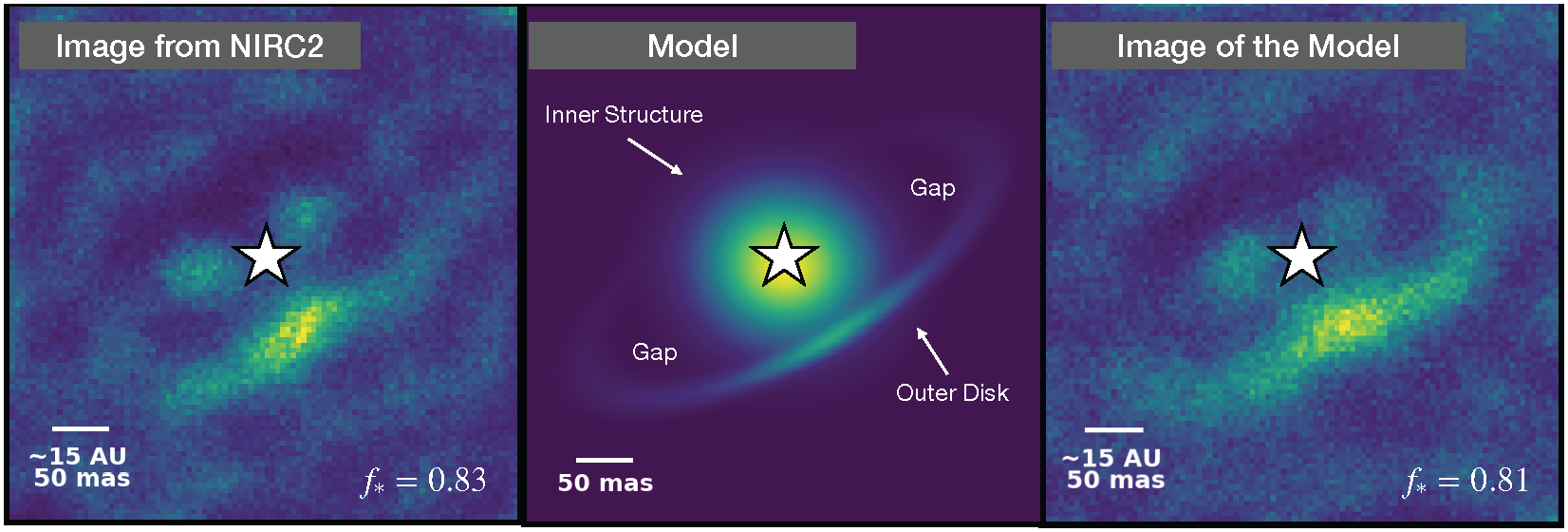Astronomers reveal tasty insights into exoplanet formation using SPAM

The NIRC2 image of dust around a young star named HD34282 (left) produced using an algorithm to construct images from aperture masking interferometry data. The light from the star is removed and its location is marked with a star symbol in all panels. The model that reproduces the data (middle) includes a circular inner structure around the star, which may be an envelope of dust. There is also a large protoplanetary disk around both the star and the inner structure. Between the inner structure and the protoplanetary disk is a ~40 AU gap, where planets may be forming. On the right is the image of the model after it is passed through the algorithm used on the left. This is done to test if the model can visually reproduce the data.
Maunakea, Hawaiʻi – Astronomers using W. M. Keck Observatory on Maunakea, Hawaiʻi Island have taken the closest-ever look at the dusty regions where planets form, offering new insight into the earliest stages of planetary birth.
HD 34282 is one of thirty objects observed thus far as part of The Search for Protoplanets with Aperture Masking, affectionately referred to as SPAM.
“We all want to know where we came from and how our solar system formed,” said Christina Vides, a graduate student at the University of California Irvine and lead author of the study published in The Astrophysical Journal. “By studying systems like this, we can watch planet formation in action and learn what conditions give rise to worlds like our own.”
Peering Into Planet Nurseries
The team used Keck Observatory’s Near-Infrared Camera (NIRC2) which enables astronomers to see closer to a star than traditional imaging methods permit.
Their target, HD 34282, is a young star about 400 light-years away, surrounded by a thick ring of dust and gas—a “transition disk” thought to be sculpted by growing planets.
With Keck Observatory’s advanced instrumentation and adaptive optics, Vides and the team captured the most detailed view yet of the inner regions of HD 34282’s disk, revealing clumpy structures and brightness patterns that hint at possible planet-forming activity.
Although no confirmed protoplanet was detected, the observations provided the closest constraints yet on where a young planet could be hiding, as well as estimates of the star’s mass and accretion rate—key clues for modeling how its surrounding material might evolve into planets.
The Rarest of Discoveries
Early detection of protoplanets is exceptionally rare and technically challenging.
PDS 70 b and PDS 70 c are the only two confirmed protoplanets that have ever been imaged directly. Both were discovered in 2020 by Caltech observers also using Keck Observatory’s NIRC2 instrument.
Each new observation builds on that legacy, bringing astronomers closer to understanding how planetary systems emerge from swirling disks of gas and dust.
“This work is pushing the boundaries of what we can see,” said Vides. “Keck’s adaptive optics and masking capabilities make it possible to resolve features just a few astronomical units from the star—regions that are otherwise completely invisible.”
What’s Next
The team will continue using Keck’s advanced instruments to study other young stars with promising disks and compile more data for SPAM. The team is also preparing for observations using future instrumentation like SCALES, a next-generation high-contrast imager now being developed for Keck Observatory, which will expand the search for protoplanets in unprecedented detail.
“Every new system we study helps us understand a little more about how planets form and evolve,” said Vides. “It’s incredible that we can point a telescope at a young star hundreds of light-years away and actually see the conditions that could give rise to new worlds.”
